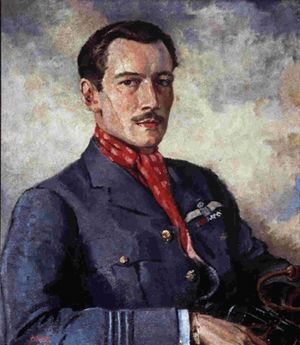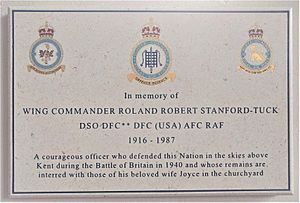Robert Stanford Tuck facts for kids
Quick facts for kids
Robert Stanford Tuck
|
|
|---|---|

Stanford Tuck in the cockpit of his Hurricane c. 1940.
|
|
| Nickname(s) | Bob |
| Born | 1 July 1916 Catford, London |
| Died | 5 May 1987 (aged 70) Canterbury, Kent |
| Allegiance | United Kingdom |
| Service/ |
Royal Air Force |
| Years of service | 1935–1949 |
| Rank | Wing Commander |
| Commands held | RAF Coltishall (1947–48) No. 257 Squadron RAF (1940–42) |
| Battles/wars | Second World War |
| Awards | Distinguished Service Order Distinguished Flying Cross & Two Bars<4>Air Force Cross Mentioned in Despatches (3) Distinguished Flying Cross (United States) |
Robert Roland Stanford Tuck (born July 1, 1916 – died May 5, 1987) was a brave British fighter pilot. He was known as a "flying ace" because he shot down many enemy aircraft. He also worked as a "test pilot," flying new planes to see how well they worked.
Tuck joined the Royal Air Force (RAF) in 1935. He first fought in the Battle of France over Dunkirk, where he got his first victories. In September 1940, he became a squadron leader and led a group of Hawker Hurricane planes. Later, in 1941–1942, Tuck flew fighter missions over northern France. On January 28, 1942, his plane was hit by anti-aircraft fire. He had to land in France and was captured. By then, Tuck had shot down 29 enemy aircraft.
Contents
Early Life and Joining the RAF
Robert Tuck was born in Catford, a part of southeast London. He didn't love school much. In 1932, he left St Dunstan's College and joined the British Merchant Navy. This meant he worked on ships at sea.
In 1935, he joined the RAF to become a pilot. After his flight training, Tuck joined 65 Squadron in September 1935. He flew older biplane aircraft like the Gloster Gauntlet and the Gloster Gladiator.
In January 1938, while practicing flying in a Gladiator, Tuck was in a mid-air crash with another pilot. He managed to parachute out safely, but he lost two teeth and got a cut on his cheek. In May 1940, he moved to 92 Squadron at RAF Croydon. Here, he flew the faster Supermarine Spitfire planes.
World War II Heroics
Fighting in France
Tuck flew his first combat mission on May 23, 1940, over Dunkirk. He quickly shot down three German fighter planes. The next day, he shot down two German bombers. As the air battles grew more intense, his number of victories quickly increased.
For his bravery, Tuck received the Distinguished Flying Cross (DFC) on June 11. King George VI himself gave him the award. The award praised his leadership and courage during fierce battles where his squadron shot down many enemy planes.
Battle of Britain
Tuck continued to have success in July and August during the Battle of Britain. On August 18, he had to parachute out of his plane. He was attacking German Junkers Ju 88 bombers over Kent. He shot one down, but his Spitfire was hit by cannon shells. He landed safely near Tunbridge Wells.
On August 25, Tuck's Spitfire was badly damaged while fighting a Dornier Do 17 bomber. He destroyed the bomber, but his plane's engine stopped. He managed to glide his damaged aircraft back to land and make a safe landing.
On September 11, during the busiest time of the Battle of Britain, Tuck was promoted. He became the leader of No. 257 Squadron RAF, which flew Hawker Hurricane planes. He led his squadron in many battles and continued to achieve more victories. He received another award, a Bar to his DFC, on October 25.
One of Tuck's victories on September 23, 1940, is thought to be against a famous German pilot named Hans-Joachim Marseille. Marseille had to parachute out of his plane after being chased by Tuck.
Fighter Missions Over France
In June 1941, Tuck was shot down over the English Channel but was rescued by a coal barge. He shot down seven enemy planes while flying the Hawker Hurricane.
Tuck had a very unlucky moment when he attacked a German bomber heading towards Cardiff. He fired at it from far away, causing it to drop its bombs in the countryside instead of on the city. However, one of the bombs hit an army training camp and killed a soldier. Sadly, that soldier was his sister's husband.
In July 1941, Tuck was promoted to wing commander. He became a "wing leader" at RAF Duxford. This meant he led groups of fighter planes on missions into northern France. He also briefly visited America with other pilots to check out new aircraft and help train American pilots. After that, he returned to RAF Biggin Hill and flew his last missions from there.
Captured as a Prisoner of War
Tuck's last mission of the war was on January 28, 1942. He was flying a low-level mission over northern France when his Spitfire was hit by enemy ground-based anti-aircraft fire (called "flak") near Boulogne. He had to crash-land and was captured by German soldiers.
Tuck later said he was scared because the soldiers were very angry. But then, something amazing happened. The soldiers saw that one of Tuck's 20mm cannon shells had gone right down the barrel of one of their own guns before exploding. This made the German gun barrel peel open "like a banana." The German soldiers found this so funny that they started slapping Tuck on the back, saying "Good shooting Tommy!" They were so excited they didn't even notice they were stepping on their dead comrades.
Tuck was first sent to a prison camp called Stalag Luft III. He helped plan parts of the famous Great Escape. But he was moved to another camp before the escape happened. He stayed there until Russian forces advanced, forcing the Germans to move the prisoners in March 1945.
Tuck finally escaped on February 1, 1945, with another pilot named Zbigniew Kustrzyński. They hid in a barn during a long march. They eventually found the advancing Russian army. Kustrzyński spoke Russian, which helped them convince the soldiers they were friendly. They had to fight alongside the Russian troops for a while. Eventually, they were sent to Vladivostok and then took a ship back to Southampton, England.
After the War
Tuck continued to serve in the RAF for a few more years. He received his last award, the American Distinguished Flying Cross, in 1946. He retired from the RAF on May 13, 1949, as a Wing Commander. He was officially credited with shooting down 27 enemy aircraft.
After retiring from the RAF, Tuck continued to fly as a test pilot. He even worked on the English Electric Canberra, a famous RAF plane.
In 1953, he and his wife, Joyce, moved to Eastry with their two sons, Michael and Simon. Tuck started a successful mushroom farm and worked there for over 20 years. He enjoyed a peaceful life on his farm in Kent. He later retired to Sandwich Bay in the 1970s.
Tuck was featured on the TV show This Is Your Life in 1956. A book about his life, called Fly For Your Life, was also written by Larry Forrester.
He also worked as an adviser for the film Battle of Britain (1969). He became good friends with a German fighter ace named Adolf Galland, who also advised on the film. Tuck was even the godfather to Galland's son.
Robert Stanford Tuck passed away on May 5, 1987, at the age of 70.
Memorials
On May 9, 2008, a special plaque was put up in Tuck's memory at St Clement's Church in Sandwich, Kent. It honors him as a "courageous officer who defended this nation in the skies above Kent during the Battle of Britain in 1940." His remains are buried there with his wife.



